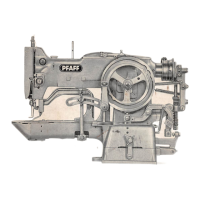The left,or knife, cam operates the needle and bobbin thread
knives.
As the knives swing forward from the inoperative to the stand-by position,
a sufficient
amount
of
thread
is pulled from the spool
and
the bobbin with
which
to
start
the
next
tack.
As the machine makes the last stitch of the tack, the
groove
in the knife cam
couses the lower, or main, tension to be
released
so
that
the
last
stitch knot
is pulled ino the material.
The main tension will not by reactivated until the machine, depending on the
subclass, has completed
three
to four stitches
after
starting a new tack. In
this way, puckering of the fabric is successfully eliminated. This is particularly
important for stitching
delicate
fabrics or sewing with long stitches.
The machine is
started
by depressing the right treadle. This action causes
the stop motion lever to swing back
and
the tripping
and
locking levers to be
interlocked.
The locking lever prevents the
operator
from inadvertently raising the work
clamp
while the machine is in
operation
since this action would cause the
knives
to
trim
the
threads.
By the
same
token, the machine
cannot
be
started
while the work clamp is
roised.
When
the machine is
started,
the driving belt is shifted from the idler to the
driving pulley and, conversely, when the machine stops, it is returned from
the driving to the idler pulley.
All the
operator
has to do to start the sewing cycle is to press down the right
treadle. After the machine has stopped automatically, she raises the work
clomp
by
depressing
the
left
treadle.
c. Sewing
Cycle
The work is held between the work clamp
and
the feed
plate
and
is
advanc
ed
after
each stitch to form the
predetermined
tack design. This design is
produced by moving the material up and across the machine bed as the
needle moves up and down. Fig. 3 illustrates the sewing cycle of a rectang
ular
tock.
When the machine has been started by depressing the right treadle, the
needle
enters
the
fobric
for
the
first
stitch.
After
the
first
stitch
has
been
completed and the needle has risen clear of the fabric again, the work is
moved across the machine bed the predetermined distance between stitches.
This cycle is
repeated
until the tack is completed.

